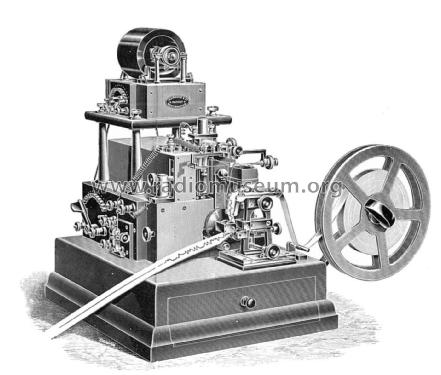Syphon Recorder
Muirhead & Co. Ltd.; Beckenham
- País
- Gran Bretaña (GB)
- Fabricante / Marca
- Muirhead & Co. Ltd.; Beckenham
- Año
- 1900 ??
- Categoría
- Eequipos de Morse & TTY, RTTY, TDD etc.
- Radiomuseum.org ID
- 299042
- Gama de ondas
- - no hay
- Tensión de funcionamiento
- Otros, detailles desconocidos.
- Altavoz
- - - No hay salida de sonido.
- Material
- Materiales diversos
- de Radiomuseum.org
- Modelo: Syphon Recorder - Muirhead & Co. Ltd.; Beckenham
- Forma
- Sobremesa, caja, normalmente con tapa (panel no inclinado).
- Anotaciones
-
The syphon or siphon recorder is an electromechanical device used as a receiver for submarine telegraph cables invented by William Thomson, 1st Baron Kelvin in 1867. It automatically records an incoming telegraph message as a wiggling ink line on a roll of paper tape. Later a trained telegrapher would read the tape, translating the pulses representing the "dots" and "dashes" of the Morse code to characters of the text message.
The syphon recorder replaced Thomson’s mirror galvanometer as the standard receiving instrument for submarine telegraph cables, allowing long cables to be worked using just a few volts at the sending end. The disadvantage of the mirror galvanometer was that it required two operators, one with a steady eye to read and call off the signal, the other to write down the characters received. Its use spread to ordinary telegraph lines and radiotelegraphy radio receivers. A major advantage of the syphon recorder was that no operator has to monitor the line constantly waiting for messages to come in. The paper tape preserved a record of the actual message before translation to text, so errors in translation could be checked.
- Mencionado en
- -- Original-techn. papers. (1903 Electrical Installations, vol. V, London: Caxton, pp. p. 49)
- Autor
- Modelo creado por Alan Larsen. Ver en "Modificar Ficha" los participantes posteriores.
- Otros modelos
-
Donde encontrará 29 modelos, 24 con imágenes y 1 con esquemas.
Ir al listado general de Muirhead & Co. Ltd.; Beckenham
